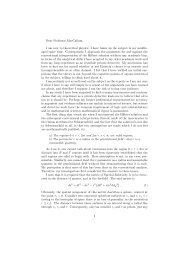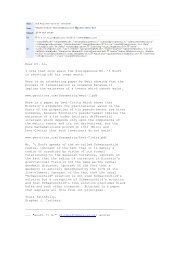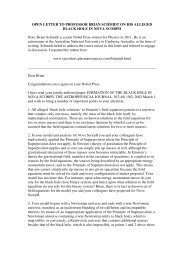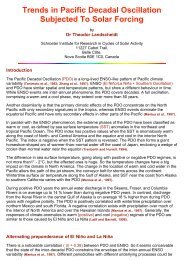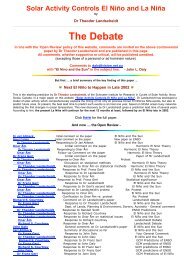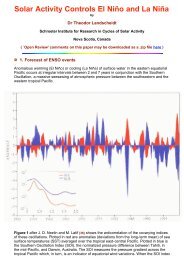Sun-Earth-Man - PlasmaResources
Sun-Earth-Man - PlasmaResources
Sun-Earth-Man - PlasmaResources
You also want an ePaper? Increase the reach of your titles
YUMPU automatically turns print PDFs into web optimized ePapers that Google loves.
4 8 SUN-EARTH-MAN; A MESH OFCOSMIG OSCILLATIONS<br />
represents intervals between consecutive ll-year maxima that reflect the<br />
secular cycle. Mlnima of DM correspond to strong sunspot maxima and<br />
inversely. The flat triangles indicate the calculated epochs of secular maxima<br />
and minima based on the secular torque cycle. The data sets are in phase. An<br />
evaluation of the totaI result for the years 300 to 1980 c onhs the high degree<br />
of synchronism of the Glrissberg-data and the calculated torque epochs. A<br />
Pearson-test yields the value 54.5 (1 degree of freedom; P 4 0.00001) for the<br />
maxima, and 22.3 (1 degree of freedom; P < 0.00001) for the minima. When<br />
subsets are formed, the results prove to be homogeneous. The torque wave<br />
points to a secular sunspot minimum past 1990.<br />
The extrema in the secular wave of IOT can be taken to constitute a smoothed<br />
supersecular wave with a quasi-period of 391 years. This long wave points to<br />
an imminent supersecular sunspot minimum about 2030.a There are<br />
indications that secular and supersecular sunspot minima are related to<br />
variations in climate. Thus a prolonged period of colder climate is about to be<br />
initiated by the secular minimum past 1990, will reachits deepest point around<br />
the supersecular minimum in 2030, and come to an end about 2070. A shorter<br />
torque cycle of 31 years, based on an analysis of a cross-correlation function<br />
of sunspots and IOT, made it possible to predict the end of the Sahelian<br />
drought three years in advance. The forecast: "The next drought maximum is<br />
to be expected about 2010. A humid period should already begin within 2 yr<br />
and reach a first maximum about 1986", was published in 1983." There was<br />
enough rain in the Sahelian countries in 1985 and still more in 1986. Geoffrey<br />
Dean, whose negative review of forecasts based on planetary constellations<br />
has been mentioned above, had received a preprint of this paper that also<br />
contained the evaluation of the positive result of the forecasts of energetic<br />
flares for the years 1979 to 1981 as well as the successful prediction of X-ray<br />
bursts > X9 in 1982. He nevertheless declared that successful predictions<br />
based on planetary configurations did not exist.<br />
'<br />
Vli. PLANETARY FQRCINGAND FLARE CYCLES 4 9<br />
VII. PLANETARY FORCING AND FLARE CYCLES<br />
Cycles of solar activity of medium wavelength, like the ll-year sunspot cycle,<br />
are also related to IQT." But even such short cycles as those that emerged from<br />
the spectral analysis of the distribution of energetic flares are connected with<br />
IOT. Strong impulses of the torque are initiated when the planet Jupiter, the<br />
centre of mass CM, and the <strong>Sun</strong>'s centre CS are in Line (JU-CM-CS). There are<br />
two types of JU-CM-CS events: those that are accompanied by a sharp increase<br />
in orbital momentum and centrifugal motion of the <strong>Sun</strong> away from CM (JU-<br />
CM-CSc), and those that coincide with a decrease in orbital momentum and<br />
centripetal motion of the <strong>Sun</strong> toward CM due to prevailing gravitation (JU-CM-<br />
CSg). These two different types can have different effects on the <strong>Sun</strong> and solarterrestrial<br />
interaction. JU-CM-CSg events that can be related to the<br />
investigated time series of energetic flares, covering the period 1970 to 1982,<br />
occurred during 1970.02 and 1982.83. They formed a cycle with a period of<br />
153.7 months.<br />
Just this cycle and harmonics of it represent most of the variance in the flare<br />
spectra discussed above.@ The most prominent amplitudes in Figures 16 and<br />
17 point to the torque cycle itself, to the exact harmoni~s 4.8 months and 2.2<br />
months with a neighbouring peak at 1.1 months, and-lo a strong amplitude<br />
at 2.8 months, that seems out of sequence, since 2.4 months would be the<br />
fitting harmonic between4.8 and 1.2 months. But the shift to 2.8 months seems<br />
to be the result of the interference with another Rare cycle in this range,<br />
regulated by tidal planets. Its mean period is 3.36 qonths. This value, when<br />
combined with the 2.4 month harmonic of the torquecycle, yields a mean value<br />
of 2.88 months which properly matches the strong amplitude at 2.8 months<br />
in the flare ~pectzum.~'<br />
This combination is consistent in so far as the torque harmonic of 2.4 months<br />
is nearer to the interfering period of 3.36 months than the torque harmonic of<br />
4.8 months. But this latter harmonic is also connected with the interfering<br />
cycle. Calculation shows that the period of the 3.36-month cycle has a range<br />
of variation of + 1.6 months. If it gets in phase with the torque harmonic of<br />
4.8 months, which occurs at irregular intervals, asa rule highly energetic X-ray<br />
bursts are released. This connection is of practical importance in assessing the<br />
category of expected X-ray bursts in predictions. There is a gap between the<br />
prominent amplihde related to the torque cycle of 154 months itself and its<br />
higher harmonics of 4.8 months and beyond. This could be due to resonance<br />
with the interfering oscillator, the period of which varies about 3.36 months.<br />
Only the higher harmonics of the torque cycle are then expected to respond.<br />
There is a wealth of papers that try to establish a relation between tidal<br />
planets and sunspots. Critical authors stress that all tidal planets, when in<br />
conjunction, could only raise a tide of a few millimeters on the <strong>Sun</strong>. But it<br />
shouId be taken into consideration that the horizontal component of the tidal<br />
forces could be of interest, as the <strong>Sun</strong>'s gravity acceleration is 28 times that of<br />
the <strong>Earth</strong>'s. E. Oepik "has shown that the mean velocity of tidal currents on<br />
the <strong>Sun</strong> can reach about one-third of tidal currents generated by the Moon on<br />
<strong>Earth</strong>. This is not negligible as the plasma in the <strong>Sun</strong> is subject to<br />
magnetohydrodynamic instabilities and turbulence. There are only few papers



